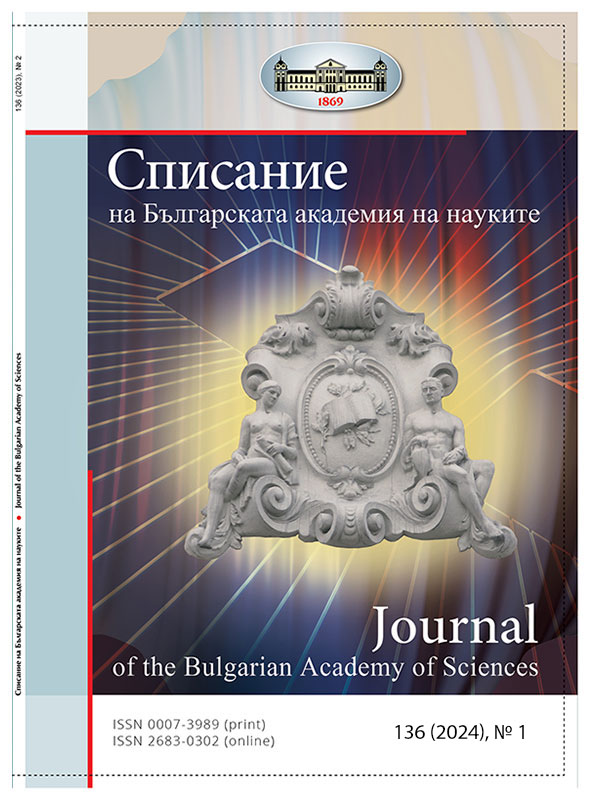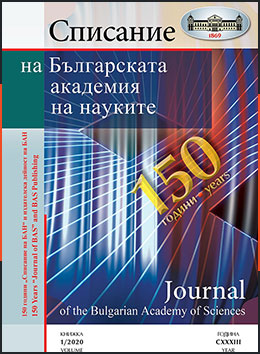Journal View
Journal of the Bulgarian Academy of Sciences
- Year: 2024
- Number: 1
- Language: Български, English
- Download Issue

-
Republic of Bulgaria’s Plan for the Use of Mesta River Waters
Author(s): Ivan Ivanov, Emil BournaskiKeywords: river water runoff, water policy, agreementAbstract: Aspects of water use of the transboundary river Mesta in Bulgaria are discussed. Greece is also very interested in the waters of the Mesta River formed on the territory of Bulgaria. Two distinct periods emerge in Bulgaria’s river water policy: – Sustainable period until 1990 with a concept of complex use of at least 75% of the river’s waters on the national territory; – Unsustainable after 1990, in which active negotiations were conducted between the governments of Bulgaria and Greece for shared use of the river’s waters in the catchment area of Bulgaria. A corresponding Agreement is signed, which is valid until 2031. A justification is given why this Agreement on the waters of the river in the catchment area of Bulgaria is useless for Bulgaria.
-
Testicular Dysgenesis Syndrome – Origin, Cellular Phenotype and Molecular Mechanism
Author(s): Nina AtanassovaKeywords: Testicular dysgenesis syndrome (TDS), androgens, testosterone, Leydig cells, testisAbstract: During the last 70 years a serious concern emerge about deterioration of male reproductive health. Disturbances in the development and functioning of the male reproductive system are accompanied by a two-fold reduction in sperm production from the testes, which dramatically increases cases of infertility. The most common reproductive disorders are congenital abnormalities (cryptorchidism and hypospadias), and that seen in young adulthood (reduced sperm count and testicular cancer). They have been observed in sons born by mothers treated with potent oestrogens during pregnancy to prevent spontaneous abortion. They represent a syndrome of common disorders, known as testicular dysgenesis syndrome (TDS) with common origin in foetal (intrauterine) life. It has been reported in many countries around the world, and hence it is assumed to be a result from the lifestyle and environmental pollution, in particular from human exposure to endocrine disrupting chemicals, widely used in everyday life. Testing the TDS hypothesis in the male faces a number of obstacles because of the long period of about 20–45 years between embryonic development, when the dysgenesis occurred and the age when adult reproductive disorders appeared. To address this issue, an experimental approach was developed in rat for in utero (foetal) treatment with antiandrogens, namely dibutyl phthalate (DBP) to elucidate the cellular and molecular mechanisms of TDS. Testes from fetuses and from animals of various ages after birth to sexual maturity were studied. Changes in testicular cell populations were followed with emphasis on the Leydig cells responsible for the synthesis of sex steroids. The Leydig cell number was evaluated in tandem with, testosterone levels and expression of key genes from the biosynthesis of steroid hormones. In the basis of TDS is a mechanism related to the both populations of Leydig cells – foetal and adult Leydig cells. Foetal Leydig cells are the origin of TDS and their dysfunction that occurs during the masculinization programming window (MPW) in the foetal period. TDS determines the risk and severity of subsequent reproductive abnormalities in the course of the testis development to the adulthood. The compensated LC failure in adulthood is the late downstream effect of TDS due to suppressed androgen production and action during MPW that is one of the severe consequences of TDS being risk to the quality and length of life of human male.
-
Polymer Carriers for Nanotherapy
Author(s): Petar Dimitrov PetrovAbstract: Nanotechnology has contributed to significant progress in the development of nanocarriers for drug delivery. The unique characteristics of nanocarriers such as small size, in vivo stability, (multi) functionality, etc., make it possible to overcome a number of problems related to poor solubility and low bioavailability of the active substance, chemical instability, unfavorable biodistribution, drug resistance, non-specific action and toxicity. Indeed, with the aid of nanocarriers, the efficiency of therapy can be significantly increased, side effects can be reduced, and the quality of life of patients can be improved. In addition, huge financial resources can be saved for the development and introduction into clinical practice of new bioactive substances. Polymers are among the preferred materials for elaborating nanocarriers due to their diversity, biocompatibility and biodegradability, and possibilities for the synthesis of nanoscale systems with different architectures and tailored physicochemical properties. Polymeric nanoparticles are applied as carriers of both hydrophobic and hydrophilic low molar mass drugs and biomacromolecules. Modern polymer chemistry and nanotechnology reveal great opportunities for the design of multifunctional nanocarriers of a new generation, which can overcome various biological barriers and deliver therapeutic agents not only to the target cells, but also to cell organelles. Nanoparticles (NPs) are being investigated and used in three different areas of medicine –controlled drug delivery (nanotherapy), diagnostics and regenerative medicine. Depending on their nature NPs can be divided into organic, inorganic, carbon, and hybrid ones. Polymers are exploited either for developing polymeric nanocarriers (micelles, polymersomes, nanogels, dendrimers, nanospheres, nanocapsules, etc.) or to modify the hydrophobic surface of inorganic and carbon-based nanoparticles for preventing their agglomeration and improving the biodistribution in the body. In general, NPs should be biocompatible to avoid damaging of healthy cells and provoking immune responses. Biodegradable NPs do not accumulate in the body as they are eliminated by kidney after delivery of therapeutics. To ensure sustained release (or targeted delivery) of the bioactive substance, nanocarriers must be stable after administration and circulate long enough (> 6 hours) in the blood stream. The presence of functional groups opens an opportunity for covalent grafting of targeting ligands (active targeting) or fluorescent molecules (imaging), stimuli responsive properties (pH, salts, etc.) and efficient cellular uptake. Although some of the newly developed drug delivery systems focus on the treatment of diabetes, atherosclerosis, chronic inflammation, etc., almost half of them are used for antitumor therapy. The reasons for this can be the insufficiently effective treatment of cancer with the available drugs (chemotherapy) and the great potential of nanoformulated systems for a breakthrough in this area of medicine. The last statement is supported by the fact that nanocarriers can selectively accumulate in tumor tissues through passive or active targeting. Multifunctional nanocarriers are among the most advanced systems for nanomedicine because they combine several beneficial properties in a single particle, which can significantly improve the efficacy of many therapeutic and diagnostic protocols.
-
The Word Temples of Valeri Petrov
Author(s): Ivan Granitski
-
Kuzman Shapkarev – Builder and Champion of the Bulgarian Language (On the Occasion of the 150th Anniversary of His Birth)
Author(s): St. Zherev
-
Corresponding Member Ivan Granitski – a Traveller to the World and to Himself
Author(s): Hristo Slavov
-
National Science Programme “Security and Defense” and the Participation of the Space Research and Technology Institute
Author(s): Petar Getsov, Garo Mardirossian, Nikolay Zagorski
-
Achievements of the National Scientific Programme “Innovative Low-Toxic Biologically Active Means for Precision Medicine (BioActivMed)”
Author(s): Pavlina Dolashka
- In the Management Board of the Bulgarian Academy of Sciences: Newly Elected Director of Institute
- Official Opening of “Geo Milev” Campus
- Corresponding Member Ilza Pazheva, Awarded with the “Marin Drinov” Badge of Honour on a Ribbon
- Women in Science Awards
- Deserved Recognition
-
Introduction to Space Exploration
Author(s): Petar Getsov
-
An Impressive Surprise
Author(s): Yachko Ivanov
- Corresponding Member Ivan Mitov
- Professor Heinz Miklas, a Friend of Bulgaria and a Foreign Member of BAS Has Died
-
In Memory of Professor Otto Spaniol, Doctor Honoris Causa of the Bulgarian Academy of Sciences
Author(s): Kiril Boyanov
Journal of BAS
ISSN 0007-3989 (print)
ISSN 2683-0302 (on line)
150 Years
"Journal of the BAS"

Sections in the Issue
In the issue you can read articles from the following sections.
